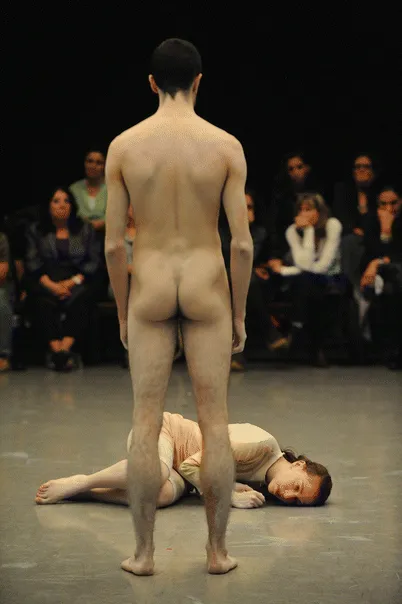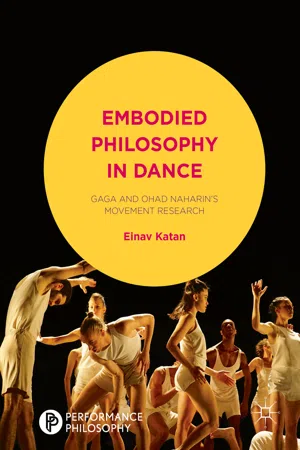1 Dance

Fig. 1.1
From Ohad Naharin’s Mamootot, Batsheva Dance Company, 2008 (2003). Dancers: Andrea Martini, Bosmat Nossan. Picture courtesy of Gadi Dagon, 2008
In the middle of the dance, one dancer steps into the center of the stage and gets undressed. A female dancer lies with her back on the floor beneath him, and observes her hands. She wears an outfit resembling the one he wore a moment before: lusterless, pastel, and pale overalls with long sleeves. Her exposed body parts are dyed with grayish powder. His naked body is covered with the same pigment. Seven dancers are sitting among the audience and looking at the two dancers in the middle. Their outfits are similar, yet distinguished from one another by small nuances and tones. In the moment described, the woman stays still; but before the man joined her in the center, she had moved there alone. In her solo, she looked as if she were unsuccessfully trying to hold on to the last forces of movement and life. She slowly folded her body on the floor, pushing it, and collapsing again. When she was shoving her body away from the ground, she gained, for a short while, a floating state in her flesh, but then again these momentary somatic lifts disappeared into breakdowns. In her movements, it seemed as if traces of living forces began to stir inside her. Then she stood up while the living vibrations she had acquired were still moving within her body. As she was slowly vibrating, her arms were flung into the air in repetitive, sharp explosions. While doing so, her fingers became thick and folded, as if she were trying, repeatedly, to reach something beyond her scope. Then her hands, limbs, and face became soft. She appeared to be calmly defeated. She then became thick again and started to shake from inside, then finally to fall, trembling, to the floor and onto her back. Alone in the space, moving as if unwonted physical impacts controlled her actions, she looked as if she were suffering and overpowered. Therefore, at the moment the man steps towards her, it seems as if he is coming to help.
He looks at her briefly, and takes off his suit. On his entrance, the woman folded her body like a baby at his feet. By the time he has gotten undressed, it seems as if perhaps he is going to cover her; however, instead of touching her, he starts to pose naked. The woman rolls on her back again. As the man begins to move, she rests and stares at her empty hands. In his exhibition, he seems to ignore her existence completely, just as he ignores his audience. His attention is directed towards himself. Thus, he seems indifferent to every single gaze in the room. At the same time, his movements and postures express sheer presentation. He shows off his muscles, and his thickly powdered body gives the impression that he is made out of stone. Due to his positions and movements, his pale, muscular body resembles a sculpture rather than a human being. His postures seem to copy an inanimate material, which imitates the celebration of life. Subsequently, the artificiality of his positions protects him from the intimacy of the audience’s stares; he is not Steffan Ferry (the dancer’s name), but rather an aesthetic material that captures the aura of the perfect male. His nudity ceases to be his own. However, since he is focused on his own moves, it looks as if he is aware of his own appearance. Consequently, he acquires a dialectical quality: as a human, admiring spectator and as his object of glorification. His dance turns into a narcissistic display. As if joyfully gaining awareness of his own objectification in praise of the human body, he starts kissing his shoulders. When he kisses himself, the tension in his flesh converts into softness. By means of this new smoothness in his physicality, he appears to regain his exclusive quality as an individual human being, one who possesses feelings and vulnerability. Suddenly, he changes his attitude and spits on his arms, strains his shoulder muscles again, and then returns to kissing his limbs. Alternately kissing and spitting on himself, he transforms between softening and tensing of his skeleton and flesh. He sits down and almost lays himself next to the still female, but then he spits on himself again, and comes back to the ritual of posing, spitting, and kissing. He observes himself; his gaze follows his own bodily positions as he transfers his stiff arms from side to side like a mobile statue.
After his performance, the female dancer rolls back towards him and stands up. He lifts her and carries her in his arms; her covered stomach touches his naked belly. They look at the audience and present themselves; her face is soft and tranquil, his face is stretched into a big smile from his mouth to his eyes, as if he is wearing a mask. She appears in front of us covered, yet exposed in her simplicity and vulnerability. He stands there unclothed, yet protected by his heroic gestures.1
2 Words
The description relates to a short sequence from Ohad Naharin’s Mamootot, a dance he created for the Batsheva Dance Company in 2003. The words describe two solos that take place successively. Translating the dance into words provides the dance with explicit verbal narration; the dancers’ actions gain metaphorical meaning, and tell a human story that goes beyond the actual movements. Watching the dance and translating it into words is an interpretative act, like the effort of describing any phenomenon; in Heideggerian terms: “it puts the movement at hand” (Zuhandenheit).2 That is to say, words provide movements with meaning by evoking their context. Consequently, the attempt to translate movement into linguistic sense is a hermeneutical act of understanding; it elaborates a tacit body of knowledge by contemplating its acts of sense making.
Following the hermeneutical tradition, making sense is an integrative act, which involves personal reformation and construction by the interpreter. Thus, on the one hand, making implicit knowledge explicit adds meanings to a phenomenon. On the other hand, this claim does not mean that this world of added meanings transgresses the phenomenon. Rather, meaning that is added needs to derive from its tacit source3; that is to say, the added meaning is already embodied in the phenomenon.
The hermeneutical definition of understanding stands in line with the essence of philosophy according to the Aristotelian tradition. Sophia, philosophical wisdom, is scientific knowledge (Episteme) combined with intuitive reason (Nous).4 Episteme is the ability to argue about things and the competence of demonstrating a conclusion through its analysis. Nous, on the other hand, is the capacity to grasp the first principle; that is to say, to perceive the origin of things.5 Thus, philosophical knowledge, accordingly, is explicit argumentation that finds its lines of analysis in a recognizable phenomenon as its source. It is following a line that is found by intuitive intelligence (the definition of Nous) rather than running with production without a source. The art of phenomenological understanding is the skill of putting into explicit argumentation implicit knowledge that one can intuitively perceive. Consequently, since philosophy of dance claims that language comprises the non-linguistic phenomena of bodily processes and aesthetic experience, it is necessary first to follow the essence of a dance, and to grasp its first principle.
The philosophical challenge of understanding dance is to elaborate implicit embodied knowledge within explicit argumentation. Thus, before dealing with the logic of linguistic argumentation, philosophy becomes a perceptual challenge. For that reason, philosophical reflections here do not lean merely on logic and theoretical grounds. Rather, the elaboration of the embodied wisdom of Gaga is first and foremost through the physical act of dancing and reflecting its bodily feeling. Physical feelings and recognitions that are evoked within the practice lead the direction of the philosophical questioning, and therefore of the argument. As a result, beyond claiming that philosophy is embodied in Gaga, this account is an inquiry concerning embodied processes of thinking, and therefore concerning the origin of understanding. Consequently, the two main arguments here are as follows. First, to deal with the embodied philosophy of dance is not merely to claim that dance conveys philosophical meanings. It is rather to claim, as Paul Valery already has, that dance is philosophical.6 Secondly, an inquiry into philosophical ideas in dance, which are physically embodied, can elaborate dance as a communicative act, but it also has the potential to clarify tacit cognitive processes within understanding and thinking.
Footnotes
1
The description of Mamootot was published first in Einav Katan, Move and Rest in Peace: “Pathosformel” in Mamootot, a Dancework by Ohad Naharin, Batsheva Dance Company, in: Ulrike Feist, Markus Rath (ed.) Et in imagine ego. Berlin: Akademie Verlag, 2012, pp. 239–54.
2
Zuhandenheit is the ability to grasp a phenomenon, in respect of knowing what it is good for. The term stands for knowing a phenomenon as a useful thing. In this sense, Zuhandenheit also encompasses the worldliness within a phenomenon. It is comprehension of something by understanding its world of reference and signs. See Martin Heidegger, Reference and Signs, in: Being and Time (1927), Joan Stambaugh (trans.), New York: State University of New York Press, 1996, pp. 71–7.
3
Wilhelm Dilthey, Selected Works, vol. III, The Formation of the Historical World in the Human Sciences, Rudolf A. Makkreel, Frithjof Rodi (ed.), Princeton, NJ: Princeton University Press, 2002, p. 235: “Understanding as such is an operation running inverse to the course of production. But a fully sympathetic reliving requires that understanding go forward with the line of the events themselves.”
4
Aristotle, The Nicomachean Ethics, Book VI: Intellectual Virtue. David Ross (ed.), New York: Oxford University Press, 2009, p. 108.
5
Ibid.
6
Paul Valery, Philosophy of the Dance, in: Roger Copeland and Marshall Cohen (ed.), What is Dance, New York: Oxford University Press, 1983, p. 55.
